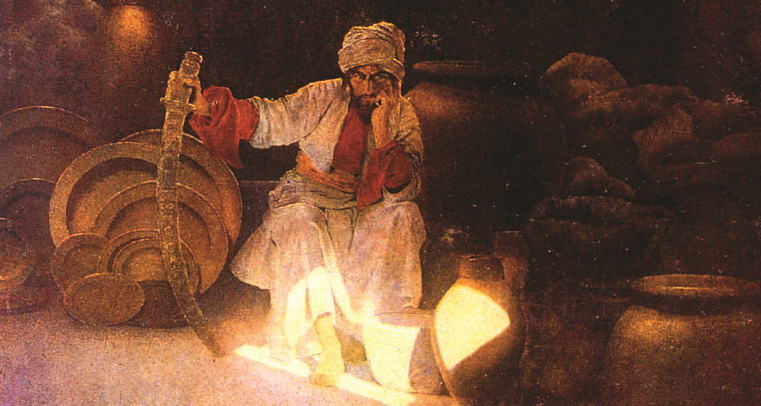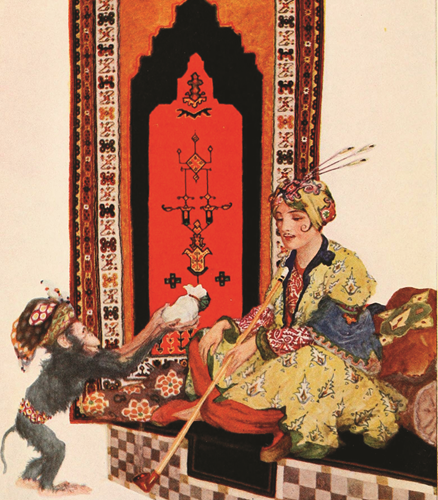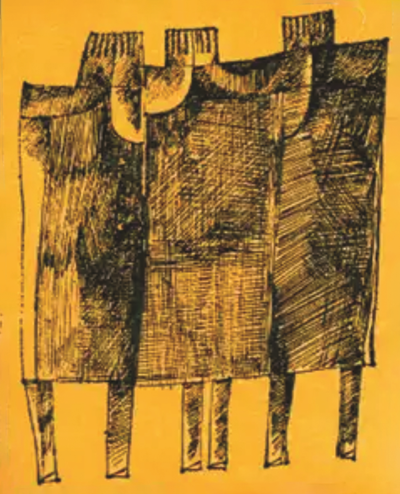-
QUALIFICATIONS
- For Linguists Worldwide
- For UK Public Services
- Preparation
- Policies & Regulation
-
MEMBERSHIP
- Join CIOL
- Professional Membership
- Affiliate Membership
- Chartered Linguist
- Already a member?
- Professional conduct
- Business & Corporate Partners
-
LANGUAGE ASSESSMENTS
- English
- All Other Languages
-
CPD & EVENTS
- Webinars & Events
- CIOL Conferences
- Networks
- CIOL Mentoring
-
NEWS & VOICES
- News & Voices
- CIOL eNews
- CIOL Awards
- The Linguist Magazine
- Jobs & Ads
-
RESOURCES
- For Translators & Interpreters
- For Universities & Students
- Standards & Norms
- CIOL & AI
- All Party Parliamentary Group
- In the UK
- UK Public Services
- Find-a-Linguist
Telling Tales

Illustration by Maxfield Parrish for Ali Baba and the Forty Thieves
Are you sitting comfortably? Eyhab Baden Eddin on the challenges of translating Arabic short stories
Translating literature is never just about words – it is about carrying stories across cultures without letting their essence fall through the cracks. Arabic short stories come wrapped in centuries of oral tradition, poetic turns of phrase, vivid cultural references and emotional undercurrents that do not always travel easily into English. So how do translators stay faithful to the spirit of the original while crafting a version that feels natural to English readers?
Some of the biggest hurdles facing literary translators working between Arabic and English include stylistic choices, gendered language, idioms and diglossia (i.e. code- switching between standard and regional dialects). This challenge is particularly acute in short stories, where the limited narrative space demands that every word carry layered meaning. Because short stories rely heavily on condensed and context-rich linguistic cues, such as regional dialects, it is essential to convey these complex elements in translation.

Stylistic fidelity
Arabic literary styles often include elaborate descriptions, rhythmic repetition and complex sentence structures. In English, however, excessive ornamentation can feel pretentious or disrupt the narrative flow. This makes it hard to maintain stylistic fidelity while ensuring the translation reads naturally. For instance, the 19th-century Egyptian writer Yusuf Idris often employs layered similes and poetic repetition that create a lyrical rhythm. Translating this into English requires careful restructuring to retain the tone without overwhelming the reader.
A similar challenge is found in the work of fellow Egyptian Zaki Mubarak. Translating his hemistich اﻟﺘمام ﻟﻴﻠﺔ ﰲ اﻟﺒﺪر وﺟﻬُﻪ literally as ‘his face was like the full moon on its brightest night’ might sound awkward or clichéd. A more context-sensitive rendering, such as ‘his face shone like a full moon’, retains the metaphor, captures the mood and tone, and carries poetic weight while keeping the flow uncluttered for English-speaking audiences.
When translated directly in English, the long opening sentence structures commonly found in classical Arabic storytelling may feel unwieldy or syntactically unfamiliar. Breaking sentences into shorter, more digestible units can improve clarity while preserving narrative elegance. This process involves artistic judgement: choosing what to retain, what to rephrase and what to omit. Take this example:
و ﰲ ﻳﻮم ﻣﻦ أﻳﺎم اﻟﺸﺘﺎء اﻟﺒﺎردة، ﺑﻴﻨما ﻛﺎﻧﺖ اﻟﺮﻳﺎح ﺗﻌﺼﻒ
ﺧﺎرج اﻟﻨﻮاﻓﺬ، ﺟﻠﺲ اﻟﺸﻴﺦ ﻋﲆ ﺳﺠﺎدة ﻗﺪيمﺔ ﰲ زاوﻳﺔ اﻟﻐﺮﻓﺔ ﻳﺘﺄﻣﻞ ﰲ اﻟﺤﻴﺎة وأﺣﻮال اﻟﺪﻧﻴﺎ، وﻳﻔﻜﺮ ﰲ ﺷﺒﺎﺑﻪ اﻟﺬي وﱃ، وذﻛﺮﻳﺎت ﻣﻀﺖ ﻻ ﺗﻌﻮد
A literal translation may feel overwhelming due to its length and pacing: ‘And on one of the cold days of winter, while the wind was howling outside the windows, the old man sat on an old rug in the corner of the room contemplating life and the state of the world, thinking of his youth that had passed, and memories that would never return.’ A more natural translation could break it up for clarity: ‘One cold winter day, as the wind howled outside the windows, the old man sat on a worn rug in the corner of the room. He was lost in thought – reflecting on life, his fading youth and memories that would never return.’ This maintains the mood and meaning while offering better rhythm and readability.
Idiomatic expressions
Idiomatic expressions are a central feature of Arabic literature, reflecting cultural norms and everyday wisdom. The idiom ﺣﻨين ﺑﺨﻔﻲ رﺟﻊ meaning ‘he returned empty-handed’ (lit. ‘he returned with Hunayn’s sandals’) comes from Al-Hariri’s Maqamat, a classical collection of 50 short stories. A literal translation would confuse most English readers, so the translator might paraphrase or use a footnote.
Arabic short stories often contain culturally specific terms that resist direct translation. Expressions like mashallah (اﻟﻠﻪ ﺷﺎء ﻣﺎ; used to ward off envy or express admiration) and wasta (واﺳﻄﺔ; ‘personal connections/influence/ nepotism’) are embedded in social context. Translators must decide whether to retain the original term, explain it through a footnote or substitute it with an approximate equivalent.
The short nature of the text heightens the translator’s responsibility to convey meaning both efficiently and evocatively. When every word is carefully chosen, culturally embedded terms carry disproportionate weight in constructing character, setting and social context.
While footnotes or paratextual explanations may be acceptable in longer texts, they often disrupt the flow and immersive quality of short fiction. Translators must often rely on subtle in-text strategies, such as brief contextualisation or near-equivalence with cultural hints. Keeping the term wasta with a brief explanation might preserve authenticity, while translating it as ‘he got the job through connections’ would communicate meaning but lose cultural nuance. Mashalla might also be kept, with ‘touch wood’ given in brackets.
Literary tone and voice
Emotional restraint is another hallmark of many Arabic short stories, which often convey emotion through understatement, indirectness or poetic imagery. In English, where clarity and directness are more typical, this can result in a tonal mismatch. For example, Zakaria Tamer’s ‘My Lord is Great’ (ﻛﺒير ربي) is about a young boy in a poor neighbourhood who faces hardships yet holds on to his faith and hope. He repeatedly says ﻛﺒير ربي as an expression of his trust in God. Translating this literally may lose its emotional weight, as the underlying firm faith emerges from the fact that God is greater than sorrow. This can be explained in a footnote as ‘God would never abandon me’ or ‘There’s a higher power watching over me’.
Intense feelings such as grief, longing and joy may be implied through silence, gesture or sparse description, reflecting a literary tradition that values subtlety over dramatic disclosure. Such restraint is not incidental; it aligns with a broader cultural tendency to convey emotion with dignity and inwardness. Thus, preserving the economy of expression is essential. The translator must resist the urge to over-explain or dramatise a line like ﺧﺪﻫﺎ ﻋﲆ ودﻣﻌٌﺔ ﺳﻜﺘﺖ، (‘She fell silent, a tear on her cheek’), or expand it (‘She broke down in tears, unable to speak from the pain’), as doing so would risk flattening the emotional nuance.

Gender and social dynamics
Short stories in Arabic often contain subtle linguistic cues reflecting class, social dynamics and gender. Translating these markers into English, which lacks Arabic’s gendered structure and social honorifics, is complex. Diglossic shifts between Modern Standard Arabic (MSA) and regional dialects mark character, mood or setting, often reflecting a shift in the emotional, spiritual or narrative tone. A colloquial dialect may indicate regional identity or lower social class, which can be hard to render in English without stereotyping. Dialects also carry connotations of intimacy, informality or marginality, while MSA is formal.
In Naguib Mahfouz’s stories, a character may speak in Egyptian dialect to show familiarity then switch to MSA in moments of solemnity. One strategy is to use more casual or fragmented English for dialects and more polished, structured English for MSA. For example, دﻟﻮﻗﺘﻲ أروح ﻋﺎوز could be rendered as ‘I wanna go now’, while ﺣﺎًﻻ اﻟﺬﻫﺎب ﰲ أرﻏﺐ might become ‘I wish to leave immediately’. In some Palestinian short stories, characters shift from colloquial Arabic to Quranic expressions signalling a move from everyday banter to spiritual reflection. Capturing this in English might involve changes in rhythm, vocabulary or tone to mimic the formal elevation.
In addition, Arabic often encodes gender through verb forms and adjectives. The description ﻣﺠﺘﻬﺪة ﻫﻲ (‘she is diligent’) uses a gendered adjective that subtly emphasises her role as a hardworking woman. In translation, this nuance might be lost unless it is contextually emphasised, for example by adding ‘despite expectations, she proved to be exceptionally diligent’.
Translating Arabic short stories into English is never a straightforward linguistic exercise – it is a subtle, deeply intuitive craft that calls upon the translator to become both cultural mediator and literary artist. We are tasked with reshaping the narrative to speak meaningfully in a new tongue, and in doing so, the translator steps into a creative space that is neither wholly Arabic nor entirely English.
Yet within these complexities lies a rare and rewarding opportunity: to produce a version of the story that does not merely replicate the original, but reawakens it for a new audience. In an age that often prizes speed over subtlety, the translator of short stories quietly defends the value of nuance. Their work reminds us that stories are not bound by language alone – and that when carried with care, a voice can cross borders not as a stranger, but as a guest, fully seen and heard.
Images (top to bottom):
Illustration by Willy Pogany for More Tales from the Arabian Nights (1915); Short stories bring joy and wisdom; Cover image for Zakaria Tamer's Tigers on the Tenth Day (1978)

Dr Eyhab Bader Eddin MCIL CL is an Assistant Professor in the Department of English Language and Literature at Dhofar University, Oman. A scholar in translation and applied linguistics, he has a broad portfolio of research and publications, and is also a mentor for the next generation of translators and linguists.
This article is reproduced from the Autumn 2025 issue of The Linguist. Download the full edition here.
More
The Chartered Institute of Linguists (CIOL), Incorporated by Royal Charter, Registered in England and Wales Number RC 000808 and the IoL Educational Trust (IoLET), trading as CIOL Qualifications, Company limited by Guarantee, Registered in England and Wales Number 04297497 and Registered Charity Number 1090263. CIOL is a not-for-profit organisation.









